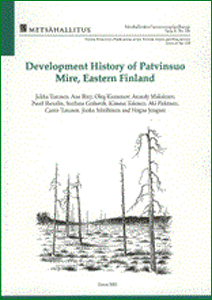Development History of Patvinsuo Mire, Eastern Finland
Patvinsuo mire (63º 05’N, 30º 40’E, 150-170 m asl.) is an extensive aapa mire and eccentric bog system located at the southern limit of the middle boreal zone. According to 14C datings, peat began to accumulated about 10500 cal. years BP, about 1000 years after the retreat of the Weichselian Land Ice.
The first vegetation communities were characterized by rich fen species (e.g. Scorpidium scorpioides) as indicated by macrofossil and chemical analyses. The rich fen stage was short and oligotrophic fen vegetation prevailed in most places, giving rise to ombrotrophic (bog) conditions over wide areas with good natural drainage. Only small areas have retained slightly mesotrophic vegetation (e.g. Molinia caerulea, Trichophorum alpinum and Sphagnum subsecundum). The initiation of the ombrotrophic bog stage began about 3500 years ago. The open-water flarks (rimpis), typical of the patterned string aapa mires, originated about 3000 cal. years BP.
Frequent mire fires have slowed vertical peat accumulation while promoting lateral peat expansion. The average rate of long-term carbon accumulation in Patvinsuo (9.2 ± 1.0 (SE) g m-2 yr-1) was clearly lower compared to the average value for reference bogs and fens in southern and central Finland (17.7 ± 0.6 (SE) g m-2 yr-1). The average rate of carbon loss in Patvinsuo mire system was 9.5 ± 1.0 (SE) g m-2 yr-1 and the mean carbon loss in an individual fire was estimated to be 2.5 kg m-2. However, growth studies of eight Sphagnum species revealed high production figures. Recent carbon accumulation rates in the mire margins paludified after latest forest fires (60 to 240 years ago) were much higher compared to long-term rates of carbon accumulation in other parts of the mire. Carbon input into the mineral subsoil beneath the peat may be an additional carbon sink, which usually exceeds the amount of carbon in the ancient forest soil prior to paludification (on average 22 g of carbon m-2 yr-1).
